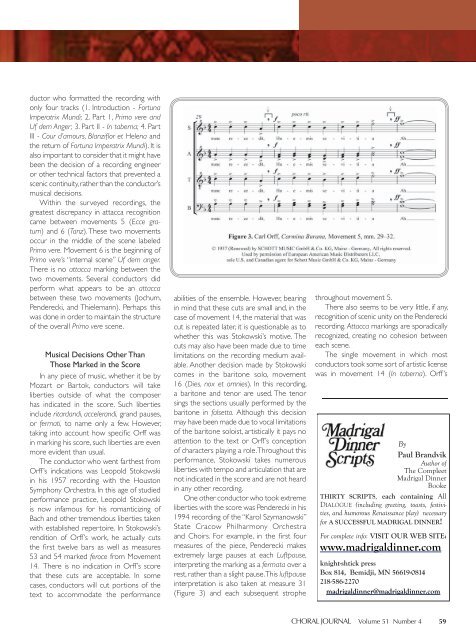CARMINA BURANA
CARMINA BURANA
CARMINA BURANA
Create successful ePaper yourself
Turn your PDF publications into a flip-book with our unique Google optimized e-Paper software.
ductor who formatted the recording with<br />
only four tracks (1. Introduction - Fortuna<br />
Imperatrix Mundi; 2. Part 1, Primo vere and<br />
Uf dem Anger; 3. Part II - In taberna; 4. Part<br />
III - Cour d’amours, Blanzifl or et Helena and<br />
the return of Fortuna Imperatrix Mundi). It is<br />
also important to consider that it might have<br />
been the decision of a recording engineer<br />
or other technical factors that prevented a<br />
scenic continuity, rather than the conductor’s<br />
musical decisions.<br />
Within the surveyed recordings, the<br />
greatest discrepancy in attacca recognition<br />
came between movements 5 (Ecce gratum)<br />
and 6 (Tanz). These two movements<br />
occur in the middle of the scene labeled<br />
Primo vere. Movement 6 is the beginning of<br />
Primo vere’s “internal scene” Uf dem anger.<br />
There is no attacca marking between the<br />
two movements. Several conductors did<br />
perform what appears to be an attacca<br />
between these two movements (Jochum,<br />
Penderecki, and Thielemann). Perhaps this<br />
was done in order to maintain the structure<br />
of the overall Primo vere scene.<br />
Musical Decisions Other Than<br />
Those Marked in the Score<br />
In any piece of music, whether it be by<br />
Mozart or Bartok, conductors will take<br />
liberties outside of what the composer<br />
has indicated in the score. Such liberties<br />
include ritardandi, accelerandi, grand pauses,<br />
or fermati, to name only a few. However,<br />
taking into account how specifi c Orff was<br />
in marking his score, such liberties are even<br />
more evident than usual.<br />
The conductor who went farthest from<br />
Orff’s indications was Leopold Stokowski<br />
in his 1957 recording with the Houston<br />
Symphony Orchestra. In this age of studied<br />
performance practice, Leopold Stokowski<br />
is now infamous for his romanticizing of<br />
Bach and other tremendous liberties taken<br />
with established repertoire. In Stokowski’s<br />
rendition of Orff’s work, he actually cuts<br />
the fi rst twelve bars as well as measures<br />
53 and 54 marked feroce from Movement<br />
14. There is no indication in Orff’s score<br />
that these cuts are acceptable. In some<br />
cases, conductors will cut portions of the<br />
text to accommodate the performance<br />
abilities of the ensemble. However, bearing<br />
in mind that these cuts are small and, in the<br />
case of movement 14, the material that was<br />
cut is repeated later, it is questionable as to<br />
whether this was Stokowski’s motive. The<br />
cuts may also have been made due to time<br />
limitations on the recording medium available.<br />
Another decision made by Stokowski<br />
comes in the baritone solo, movement<br />
16 (Dies, nox et omnies). In this recording,<br />
a baritone and tenor are used. The tenor<br />
sings the sections usually performed by the<br />
baritone in falsetto. Although this decision<br />
may have been made due to vocal limitations<br />
of the baritone soloist, artistically it pays no<br />
attention to the text or Orff’s conception<br />
of characters playing a role. Throughout this<br />
performance, Stokowski takes numerous<br />
liberties with tempo and articulation that are<br />
not indicated in the score and are not heard<br />
in any other recording.<br />
One other conductor who took extreme<br />
liberties with the score was Penderecki in his<br />
1994 recording of the “Karol Szymanowski”<br />
State Cracow Philharmony Orchestra<br />
and Choirs. For example, in the fi rst four<br />
measures of the piece, Penderecki makes<br />
extremely large pauses at each Luftpause,<br />
interpreting the marking as a fermata over a<br />
rest, rather than a slight pause. This luftpause<br />
interpretation is also taken at measure 31<br />
(Figure 3) and each subsequent strophe<br />
throughout movement 5.<br />
There also seems to be very little, if any,<br />
recognition of scenic unity on the Penderecki<br />
recording. Attacca markings are sporadically<br />
recognized, creating no cohesion between<br />
each scene.<br />
The single movement in which most<br />
conductors took some sort of artistic license<br />
was in movement 14 (In taberna). Orff’s<br />
By<br />
Paul Brandvik<br />
Author of<br />
The Compleet<br />
Madrigal Dinner<br />
Booke<br />
THIRTY SCRIPTS, each containing All<br />
DIALOGUE (including greeting, toasts, festivities,<br />
and humorous Renaissance play) necessary<br />
for A SUCCESSFUL MADRIGAL DINNER!<br />
For complete info: VISIT OUR WEB SITE:<br />
www.madrigaldinner.com<br />
knight-shtick press<br />
Box 814, Bemidji, MN 56619-0814<br />
218-586-2270<br />
madrigaldinner@madrigaldinner.com<br />
CHORAL JOURNAL Volume 51 Number 4 59








